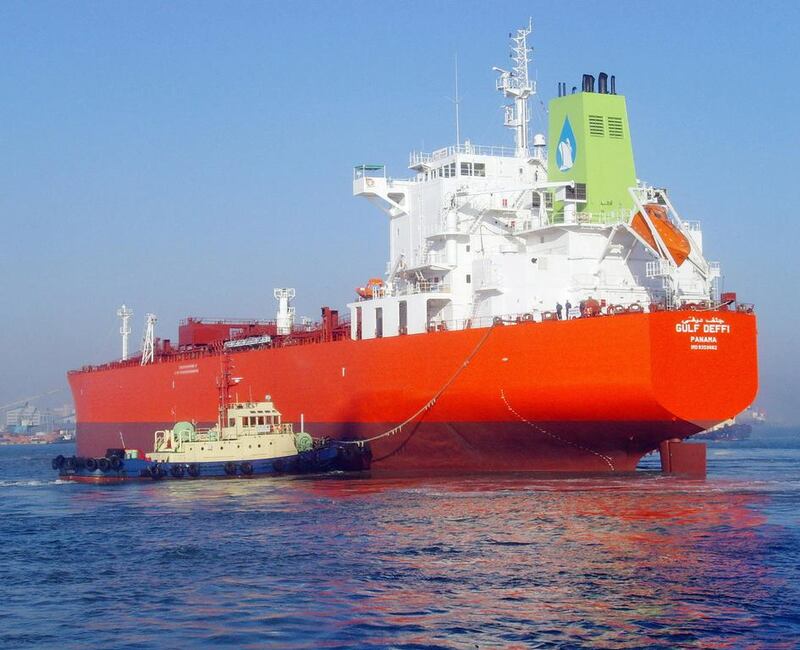Two years ago, Abdullah Al Shuraim,the chairman of the Dubai shipping company Gulf Navigation, announced his company's latest achievement – buying up so much tanker capacity that its fleet could transport the daily output of the world's top crude exporter.
But today the company is now in a fight to regain control of two supertankers, currently held in foreign ports, that it bought to transport the largest of crude cargoes.
“We have multiplied our crude-carrying capacity four times to equal the crude export of Saudi Arabia for one day,” Mr Al Shuraim said two years ago. “Our five-year plan reflects a forward-thinking strategy that will take Gulf Navigation Holding to a heightened level of global competitiveness.”
Those heady plans at the time included doubling the company’s fleet of Very Large Crude Carriers (VLCCs), mega tankers capable of transporting 2 million barrels of crude, more than two thirds of the UAE’s daily output – to four by this year, and further growing that to nine by 2015.
Mr Al Shuraim was not alone at the time. Since 2008, 140 supertankers were built, bringing global capacity to 600 ships – between 50 and 70 more than required by the market, according to the shipping giant Maersk.
Since 2011, the optimism about the mammoth tankers has evaporated. The oversupply of rapidly built tanker capacity has decimated rates, forcing tanker companies around the world to operate their ships at a loss. Rates that averaged US$229,484 in December 2007 have shrunk to $7,296 since the start of this year, the lowest since the London shipbroker Clarkson began tracking data in 1997.
The oversupply has taken a toll on operators across the globe. Overseas Shipholding Group and General Maritime Group of the United States have filed for bankruptcy. Euronav, the Belgium-based tanker owner, reported a loss of $27.2 million for the third quarter.
And Gulf Navigation, in a turnaround from its 2011 plans, said last month it would seek shareholder approval to temporarily exit the oil tanker business to focus on the chemical transport business.
The announcement was book-ended by the seizures of its two VLCCs by creditors, first in Rotterdam and later in the Bahamas.
To bolster rates, shipowners are resorting to slowing down empty ships, which effectively reduces the number of available vessels, and destroying ships.
Companies are expected to scrap about 23 VLCCs a year from now through 2016, according to E A Gibson Shipbrokers in London. Shrinking capacity will help to nearly triple daily rates to $22,000 by next year, but not enough to break even, according to a survey of analysts by Bloomberg News.
One of the advocates of demolishing vessels, Frontline of Bermuda, said that to break even, it would require rates of $25,000, which are not expected before 2015.
“If we are talking crude, there is no positive development in sight,” said Hanne Sørensen, the chief executive of Denmark’s Maersk Tankers. “There is a massive oversupply with a fleet of more than 600 ships and therefore, the only way for the market to improve rapidly is to begin scrapping and idling ships which is not likely.”
Another option, consolidating shipping companies, would require such a large scale that it would be impractical, she told the trade publication ShippingWatch.
“I think a consolidation will be next to impossible,” she said. “You will have to acquire a large share of the market in order to really do anything with the prices.”
Demand is also being pushed down by declines in American and European imports, as well as a slowdown in the growth of Chinese imports – markets that represent more than half the world’s demand for seaborne crude.
A rise in American oil output to its highest since 1992, thanks to shale technology, have pushed imports down to 75 per cent of their peak in 2005, according to the US government.
Demand from European Union customers is projected to dip 2 per cent this year, equivalent to the capacity of 18 supertankers, and China’s imports have grown this year at a relatively modest 3 per cent as economic growth slows.
ayee@thenational.ae





